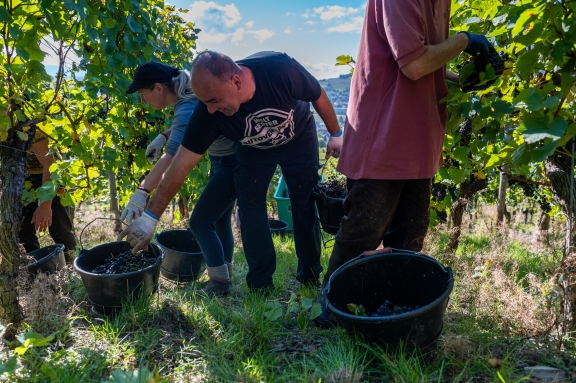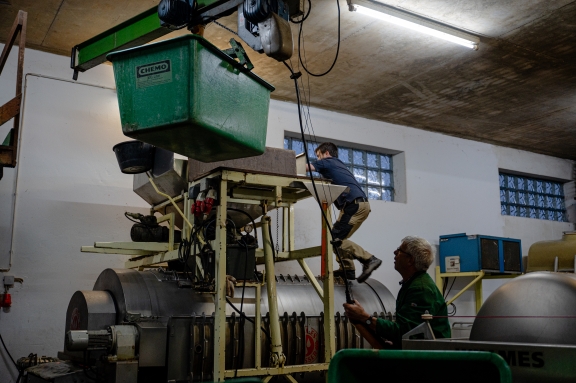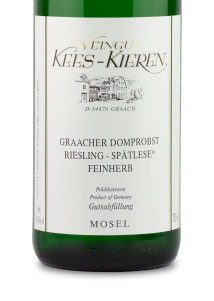
Viticulture agriculture - craftmansship - art
The grape harvest is the crowning moment of every growing season and probably the busiest, most intense phase in winemaking. It's a time when family pulls together, with each person playing an essential role in the workings of the winery.
The process begins with setting the harvest start date. If you start too early, the grapes aren't fully ripe and lack flavor. Wait too long, and rot can set in, quickly reducing the harvest. Timing is crucial, and it must be communicated in advance so that everyone can make arrangements to join in.
Our grape-picking season starts with hand-harvesting, especially for our Rieslings, Pinot Blancs, and Pinot Noirs. Hand-picking lets us carefully sort and select, true to the motto "the good into the pot, the bad into the crop." Throughout the four weeks of harvest, we often adjust our plans daily, as each vineyard matures at its own pace. Decisions on where to pick the next day are made the evening before, aiming to capture the best quality from each location.
Harvest timing depends on many factors: grape ripeness, sugar levels, the unique traits of each vineyard, grape variety, and one of the most unpredictable factors – the weather. The coordination between vineyard and cellar teams is key; it’s not just about picking the ripest grapes but also planning ahead for what each harvest batch will become.

Different wines in our collection require different qualities from the grapes. For instance, our high-quality Prädikat and single-vineyard wines need to meet specific standards for sugar levels and vineyard origin. Dry wines, with their low sugar content, reveal every subtlety, so we choose only the healthiest, fully ripe grapes for them.
A vineyard isn’t harvested all at once; it often takes multiple visits. In the pre-harvest stage, we pick only the overripe grapes, leaving the rest to reach full ripeness. This is followed by the main harvest, where we take all the grapes off the vines, carefully separating any unripe or rotten ones.

The Mosel region is world-famous for its steep, slate-filled slopes, with inclines of up to 75%, which require special equipment to handle the harvest. Sturdy footwear is a must, and our buckets are designed to stay on steep terrain. Grapes are collected in large containers, which are pulled up the hillside by a winch and loaded onto our Unimog truck with a crane arm. This gentle transport minimizes mechanical stress on the grapes, preserving the flavor by preventing the release of harsh compounds from the grape stems.
Once at the winery, the cellar team takes over. Grapes are fed into the press or grape mill by a crane, allowing gravity to carry them to the press. Only in the mill are the grape skins gently broken to enhance juice extraction.
Our Pinot Noir grapes for red wine require a different approach because their color is in the skin, not the juice. To extract the color, we leave them to ferment as whole grapes for several days before pressing.
The press extracts all juice from the grapes, leaving behind dry pomace. The juice, or must, is then pumped into cooling vats to preserve its aromas and prevent early fermentation. Here, we get a first taste of the must, revealing hints of what the wine will become.
Not all grapes go through the large presses; select grapes for Auslese and higher Prädikat wines require more delicate handling to release their "liquid gold." These grapes are hand-sorted again until only raisin-like berries remain, which are then pressed in a small, specialized press overnight. The yield is small but exceptionally precious.
To be continued in next years newsletter.
2024 The year at the Mosel
The year 2024 challenged us in many ways. An unusually warm spring led to an early budding of the vines, but at the end of April, we were surprised by a late frost, which caused significant damage in affected areas. Shortly thereafter, a hailstorm in early May brought further setbacks.
The entire following summer was cool and marked by heavy rainfall, which slowed the growth cycle of the vines and grapes. Fortunately, September brought some improvement in the weather. Nevertheless, by mid-October, we had already reached the annual average rainfall for a typical year, highlighting the weather challenges during this growing season. The grape harvest, which we started for the Riesling in early October, had to be interrupted repeatedly, as frequent rains threatened to dilute our crop. We harvested the last grapes on October 25 after about four weeks of picking.
Despite the unpredictable weather, we are satisfied with the quality of our grapes. They were flavorful and rich in extract, although this year did not produce the very top quality in the Auslese range. Due to frost, hail, and adverse weather and its consequences, we had to accept a yield reduction of about 30% compared to the previous year. Still, the wines we have brought into the cellar promise good quality – perhaps even because of these challenges.
The year 2024 demanded a great deal from us, but it once again underscored the importance of patience and dedication in winemaking. Despite all the challenges, our passion for wine and our vines remains unbroken – and we look forward to offering you exceptional wines from the 2024 vintage next year.
2023 The vintage
The year 2023 in the Mosel region was marked by a shortened yet intense harvest season, bringing the Riesling grape to the forefront. Our vines adapted remarkably well to the year’s extreme weather conditions. The hot and dry summer, particularly in June, initially led to drought stress and occasional sunburn on the grapes. However, the abundant rainfall at the end of July provided much-needed relief. In September, the warm nights of the “golden autumn” accelerated grape ripening, ultimately resulting in an excellent balance of acidity and sweetness – especially in our Rieslings, which developed optimally.
The 2023 vintage has produced opulent wines that display both power and volume without losing the delicate finesse typical of the Kabinett category. The fine acidity structure gives the wines vibrancy and supports their exceptional aging potential. Sweet wine enthusiasts, in particular, can look forward to this vintage, as we were able to restock our Beerenauslese reserves for the first time in a long while. But even the “Spätlesen” reflect the impressive opulence of this vintage.
We are extremely pleased with the development of our wines and the success they have already achieved. In the Moselweinwerbungs annual selection tasting, our 2023 Graacher Domprobst Kabinett trocken (no. 04) achieved an excellent 2nd place in the Riesling Kabinett dry category. At the prestigious Mosel CUP of Gourmetwelten 2024, which brought together top international wineries and newcomers, three of our wines made it into the TOP 20 of their respective categories. We are particularly proud of the 3rd place achieved by our 2023 Graacher Himmelreich Spätlese** (no. 21), while our 2023 Domprobst Spätlese feinherb (no. 13) was also selected among the TOP 20.
On the state level, the quality of our wines was also recognized: out of the 18 wines submitted, 16 were awarded with the gold medal by the chamber of agriculture. In November 2024, we look forward to the renewed awarding of the State Honorary Prize by the Chamber of Agriculture, which crowns our long-standing work and the success of this outstanding vintage.
The 2023 wine year impressively showcases how our winery rises to the challenges of nature, producing wines of the highest quality that will bring enjoyment for many years to come.
Graacher Domprobst Riesling Kabinett trocken
Der kräftigere, bodenständigere Kabinettwein. Der tonschieferhaltige Boden gibt dem Wein Tiefe und einen eigenen Charakter. Mit diesem unkomplizierten Kabinett liegen Sie nie verkehrt.
Graacher Himmelreich Riesling Spätlese**
Wie eine noch etwas fülligere Matrone kommt diese Spätlese aus noch reiferen Trauben daher. Trotzdem hat sie ihre tänzerische Eleganz nicht verloren. Süße spielt mit Säure und lässt einen nicht satt werden von dem Wein.
Graacher Domprobst Riesling Spätlese* feinherb
Komplexer, körperreicher Wein mit dominierenden Zitrusfruchtaromen, setzt sich hinsichtlich Kräftigkeit und Aromatik vom Kabinett ab


